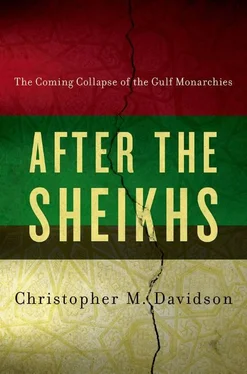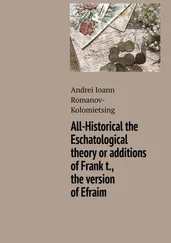Much like the Al-Saud and the Al-Sabah, the ruling families of the former Trucial States have also ruled unopposed since their independence. In Bahrain’s case, Isa bin Salman Al-Khalifa ruled from 1961 until his death in 1999 when he was peacefully succeeded by his eldest son, Hamad bin Isa Al-Khalifa, who continues to rule. Succession in Qatar has, by contrast, been much more complicated, with Ahmad bin Ali Al-Thani being deposed in 1972, one year after Qatar’s independence, by his cousin Khalifa bin Hamad Al-Thani. Then, in 1995 Khalifa was dramatically deposed by his second wife’s eldest son, Hamad bin Khalifa Al-Thani. Nevertheless, the overall authority of the Al-Thani dynasty has never come under serious question, with the family remaining in tight control of Qatar. In Abu Dhabi, after succeeding his unpopular older brother with some degree of British assistance in 1966, [128] 72. The unpopular older brother being Shakhbut bin Sultan Al-Nahyan. See Davidson, Christopher M., Abu Dhabi: Oil and Beyond (London: Hurst, 2009), chapters 2–3.
Zayed bin Sultan Al-Nahyan enjoyed a long and relatively untroubled reign. His death in 2004 was closely followed by the succession of his eldest son and long-serving crown prince, Khalifa bin Zayed Al-Nahyan. But following a secret family agreement reached in 1999 which saw Khalifa’s ambitious younger half-brother, Muhammad bin Zayed Al-Nahyan, being appointed as deputy crown prince, [129] 73. Ibid., p. 99.
Muhammad was then immediately upgraded to crown prince following their father’s death — despite Khalifa having two adult sons. Since then, Muhammad has risen to become one of the most powerful members of the Al-Nahyan family, controlling most key policy areas in the emirate. In neighbouring Dubai, the Al-Maktoum family had a similarly long-serving patriarch, with Rashid bin Said Al-Maktoum ruling from 1958 until his death in 1990. Survived by four sons, his eldest — Maktoum bin Rashid Al-Maktoum — duly succeeded. However, and as something of a precursor to the Al-Nahyan succession arrangements, he appointed one of his younger brothers — Muhammad bin Rashid Al-Maktoum — as crown prince in 1995, rather than one of his own sons. Between then and 2006, when Maktoum died, Muhammad was Dubai’s de facto ruler, and thus his eventual succession in 2006 was little more than a formality.
The ruling families of the smaller former Trucial States have, like Qatar, been a little more prone to internecine disputes and ‘palace coups’. In Sharjah’s case, only a year after independence its ruler Khalid bin Muhammad Al-Qasimi was assassinated by an exiled former ruler, Saqr bin Sultan Al-Qasimi. Turning to Khalid’s most educated younger brother, the ruling family appointed Sultan bin Muhammad Al-Qasimi as ruler. In 1987 Sultan’s passed-over elder brother, Abdul-Aziz bin Muhammad Al-Qasimi, briefly seized power before Sultan was able to reassert control. [130] 74. Davidson (2008), pp. 252–253.
Similarly, in Ra’s al-Khaimah the succession process has been bumpy, although the ruling Al-Qasimi family’s authority has never been directly contested. As discussed later in this book, the emirate’s long-serving ruler, Saqr bin Muhammad Al-Qasimi, had appointed his eldest son, Khalid bin Saqr Al-Qasimi, as crown prince in 1961. But in 2003 the aging Saqr had switched crown princes, choosing one of his younger sons, Saud bin Saqr Al-Qasimi. [131] 75. Ibid., pp. 259–262.
Although Khalid was forced into exile, his return to Ra’s al-Khaimah following Saqr’s death in 2010 prompted a brief crisis before Saud was eventually confirmed as the new ruler.
The period immediately before and after the Trucial States’ independence from Britain in 1971 deserves special attention, as it has had important ramifications for these monarchies’ subsequent state formation process. In 1968 the British government announced that within just three years it would dismantle all of its bases and treaties ‘east of Aden’, in an effort to cut imperial expenditure and focus more resources on Britain’s struggling domestic welfare system. The ruling families of the Trucial States were so alarmed by the prospect of their protector’s departure that they even offered to subsidise the deployment of British troops in the region after independence was granted. [132] 76. Davidson (2005), chapter 1. The offer was rejected by the British government on the grounds that British armed forces could never be deployed as a mercenary force.
Britain’s solution, however, was to encourage the various rulers to form a cohesive federation that would provide their sheikhdoms with at least some degree of collective security.
Various meetings and negotiations took place, but it quickly became apparent that Bahrain and Qatar were unwilling to form a state with their less developed neighbours, [133] 77. For a full discussion see Davidson (2009), chapter 3. Qatar also seemed to have hoped that the capital of the federation would be Doha. See Fromherz, Allen J., Qatar: A Modern History (London: IB Tauris, 2012), p. 18.
with both declaring themselves independent emirates in summer 1971. To make matters worse, Ra’s al-Khaimah was also baulking at joining the federation, as it too held ambitions to become an independent state. Moreover, on 1 December 1971—the day before Britain’s official withdrawal — Iran had seized three contested islands belonging to Sharjah and Ra’s al-Khaimah, thus further alarming the remaining Trucial States rulers. Nonetheless, the following day a six member federation of United Arab Emirates was inaugurated, [134] 78. Comprising Abu Dhabi, Dubai, Sharjah, Ajman, Umm al-Qawain, and Fujairah.
and the next month Ra’s al-Khaimah reluctantly agreed to join. Given that Abu Dhabi commanded the bulk of the UAE’s oil reserves it became the federal capital and its ruler, Zayed, was installed as the UAE’s first president with Dubai’s ruler, Rashid, as vice president. [135] 79. Davidson (2009), pp. 56–61
Much like Kuwait, Bahrain began its period of independence with an attempt at building a parliament as the ruling family sought to involve the influential merchant community. A constitution was drawn up detailing a fully elected body with an all-male electorate, and the first ballots were cast in 1973. Political parties were forbidden and the unelected prime minister — Khalifa bin Salman Al-Khalifa — was a member of the ruling family. Nonetheless some political blocs did form, and a brief period of vibrant debate ensued. But within just two years the emir moved to dissolve the parliament. Members had begun to dispute the Al-Khalifa family’s enthusiasm for an American military presence in Bahrain and were frustrated over the lack of land reform, with the Al-Khalifa continuing to own most of the island’s territory. Moreover, parliament had crossed another red line by calling for a more transparent state budget as oil revenues boomed. [136] 80. Kinninmont, Jane. ‘Bahrain’ in Davidson, Christopher M. (ed.), Power and Politics in the Persian Gulf Monarchies (London: Hurst, 2011), pp. 37–38.
Thus, for most of the 1980s the only spaces for political discussion in Bahrain were in more traditional settings, in particular the majalis for Sunni citizens, and the ‘mourning houses,’ or mataams for Shia citizens. [137] 81. Ibid., p. 46. The mataams being the mourning houses for Imam Hussein bin Ali, a key Shia martyr and member of the Prophet Muhammad’s household.
By the early 1990s, with deepening security ties between the Al-Khalifa and the US, and with rising unemployment and falling incomes, hundreds of Bahrainis petitioned the emir for a reinstatement of the 1973 parliament, but only an appointed advisory council was established. Further opposition and fresh demands in the 1990s — detailed later in this book — were similarly unsuccessful, with the emir refusing to re-open parliament.
Читать дальше












